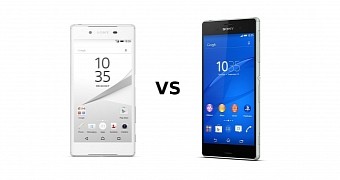Sony fans weren’t really impressed when, a few months ago, the Japanese device maker rolled out the Xperia Z3+ (or Xperia Z4 in Japan), so most of them decided to continue sticking with the Xperia Z3 which was launched back at IFA 2014.
A year later, Sony comes back to Berlin with a new flagship called the Xperia Z5. So if you haven’t upgraded your smartphone since the Xperia Z3, you might want to consider this newcomer, which will be making an appearance on the market next month.
But what are the key differences between this year’s flagship and last year’s? Take a look below to see whether Sony has really taken the time to improve upon the Xperia Z3 or not.
Design - mostly the same
At some point in the past, rumors started circulating that Sony’s Xperia Z5 flagship would mark a change in design aesthetics for Sony. Well, now that the phone is official, we can say that the claims were pretty over-exaggerated.
The phones have the same dimensions (5.75 x 2.83 x 0.29 inches / 146 x 72 x 7.3 mm) and both come equipped with 5.2-inch displays. Still, Sony has embedded some subtle changes on board the Xperia Z5.
As with the Xperia Z3, the Xperia Z5 is made of metal and glass, but this time around, the back panel features a “frosted glass” finish which makes the phone less slippery. In contrast, the Xperia Z3’s back is quite glossy and prone to smudges.
Upon closer inspection, it can also be noticed that the Xperia Z5’s metal frame is slightly flattened across the sides, while the Xperia Z3 has curved ends.
Display - nothing has changed
Sony has been quite skittish to incorporate QHD panels on its flagship lines. However, with the Xperia Z5 Premium, it went directly overboard and added a 4K display. Anyway, going back to the Xperia Z5, the flagship comes with the same 1920 x 1080 pixel resolution and 424 ppi as the Z3.
It appears that Sony has been working to tweak the color temperature, so you won’t probably notice crazy amounts of blue as it happened when you looked at the Xperia Z3.
Performance - another shot at the Snapdragon 810
This year, Sony did it again and used a Snapdragon 810 inside the Xperia Z5. The Xperia Z3+ was also powered by a Snapdragon 810, but soon after the phone launched, customers started complaining of overheating issues.
Hopefully, this time around, Sony has found a way to keep these problems under control with the new phone. Last year’s Xperia Z3 relies on a Snapdragon 801 and both handsets come with 3GB of RAM on board.
As for internal storage, the Xperia Z3 offered 16GB models, while the Xperia Z5 will probably launch with 32GB of storage.
Software - the two are on par
Sony has provided Xperia Z3 with the Android 5.1 Lollipop update and we can expect to find the same thing on board the Xperia Z5. Naturally, Sony has added its proprietary Xperia UI, which means a whole bunch of tools, apps and features will be waiting for you on the phone.
Fingerprint sensor
The Xperia Z3 doesn’t come with a fingerprint scanner, but with the Xperia Z5, Sony is finally offering this function. So the company has added its own biometric scanner on board the new handset, which resides in the power key that has been made lager than the one on the Xperia Z3.
So if you are looking for a handset with a fingerprint scanner, the Xperia Z5 is for you.
Cameras
The Xperia Z3 came boasting a 20.7MP main camera with autofocus and LED flash, plus a 2.2MP secondary camera for selfies and such. Well, Sony has upgraded things in the camera department, so the Xperia Z5 now offers a 23MP back shooter with autofocus and LED flash, plus a 5.1MP secondary camera.
In conclusion
As you can see, Sony hasn’t gone out of its way to really make the Xperia Z5 stand out when compared to its predecessor. Sure, there are a few tweaks here and there, but it seems to us that the new flagship is a mixed bag.
We’re dealing with a phone that is similar in design to the Xperia Z3, has a Snapdragon 810 on board, but brings a better photography experience and takes advantage of a fingerprint scanner. Still, are these reasons enough to upgrade?

 14 DAY TRIAL //
14 DAY TRIAL //